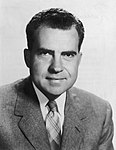| |||||||||||||||||
| |||||||||||||||||
| |||||||||||||||||
| Elections in California |
|---|
 |
| ||
|---|---|---|
|
Pre-vice presidency 36th Vice President of the United States Post-vice presidency 37th President of the United States
Judicial appointments Policies First term Second term Post-presidency Presidential campaigns Vice presidential campaigns
 |
||
An election for a seat in the United States House of Representatives took place in California's 12th congressional district on November 5, 1946, the date set by law for the elections for the 80th United States Congress. In the 12th district election, the candidates were five-term incumbent Democrat Jerry Voorhis, Republican challenger Richard Nixon, and former congressman and Prohibition Party candidate John Hoeppel. Nixon was elected with 56% of the vote, starting him on the road that would, almost a quarter century later, lead to the presidency.
First elected to Congress in 1936, Voorhis had defeated lackluster Republican opposition four times in the then-rural Los Angeles County district to win re-election. For the 1946 election, Republicans sought a candidate who could unite the party and run a strong race against Voorhis in the Republican-leaning district. After failing to secure the candidacy of General George Patton, in November 1945 they settled on Lieutenant Commander Richard Nixon, who had lived in the district prior to his World War II service.
Nixon spent most of 1946 campaigning in the district, while Voorhis did not return from Washington D.C. until the end of August. Nixon's campaign worked hard to generate publicity in the district, while Voorhis, dealing with congressional business in the capital, received little newspaper coverage. Voorhis received the most votes in the June primary elections, but his percentage of the vote decreased from his share in the 1944 primaries. At five debates held across the district in September and October, Nixon was able to paint the incumbent as ineffectual and to suggest that Voorhis was connected to communist-linked organizations. Voorhis and his campaign were constantly on the defensive and were ineffective in rebutting Nixon's contentions. The challenger defeated Voorhis in the November general election.
Various explanations have been put forward for Nixon's victory, from national political trends to red-baiting on the part of the challenger. Some historians contend that Nixon received large amounts of funding from wealthy backers determined to defeat Voorhis, while others dismiss such allegations. These matters remain subjects of historical debate.


